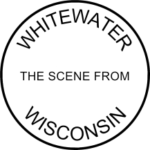 This is the twelfth post in a series considering related local topics of cultures & communications within the city.
This is the twelfth post in a series considering related local topics of cultures & communications within the city.
There are several news (or news-release dependent) publications in Whitewater: the Daily Union, Gazette, and Banner. Add to that over a dozen Facebook pages, and a few local government websites (city, school district, university in particular), and one might expect a diversity of opinion. (I’d certainly favor that diversity.)
It’s not yet here, however. These publications share a similar point of view: touting the local (or hyper-local) as exceptional, from an almost uniformly right-leaning direction. (Right-leaning as they see it: support for government intervention in the marketplace and cultural conservatism everywhere else. There’s much talk about businesses, but almost none about the free markets that make business and labor transactions efficient. Nor is there even one of these publications that’s introspective; indeed, on this last point, their publishers would probably mistake their own views for the natural order of the universe.
(I don’t know how many people on the planet treat municipal emblems with the kind of reverence that one might show for a holy icon, but if there’s a sociologist who’d like to study that outlook, Whitewater’s coördinates are 42°50’6″ N 88°44’10” W. )
Into this environment comes a public relations and media manager for the city of Whitewater. A sharp, long-time reader pointed out the problem with a public-relations manager for city government: the Banner’s politician-publisher now does that job for free. Not as stylishly as a media manager could, to be sure, but with a thrall to authority that never fails. The advantages of a private publication are lost when its publisher has spent decades holding public offices.
Most of these publications have an elderly readership; the rest have elderly publishers or (for organizations with Facebook pages) an elderly membership. Those wondering what happened to the bobby soxers will find the answer at the city manager’s annual state of the city update, where senior citizen attendees turn out for autographs to listen appreciatively.
The real gap is a demographic one: Whitewater’s residents in their 70s & 80s don’t look like residents in their 20s and 30s. (For that matter, I don’t look like residents in their 20s and 30s, but then I don’t claim to hold anything other than a single perspective, as an emissary of one, so to speak.)
Whitewater’s mostly churning the same cream through similar churns, and finding that the butter all tastes the same.
Previously: Parts 1 (introductory assumptions), 2 (population), 3 (oasis), 4 (demographics), 5 (working age), 6 (divided), 7 (how it was supposed to be), 8 (nearby), and 9 (small-town harvards), 10 (mailers), and 11 (fiestas and apple orchards).
Tomorrow: Part 13.
